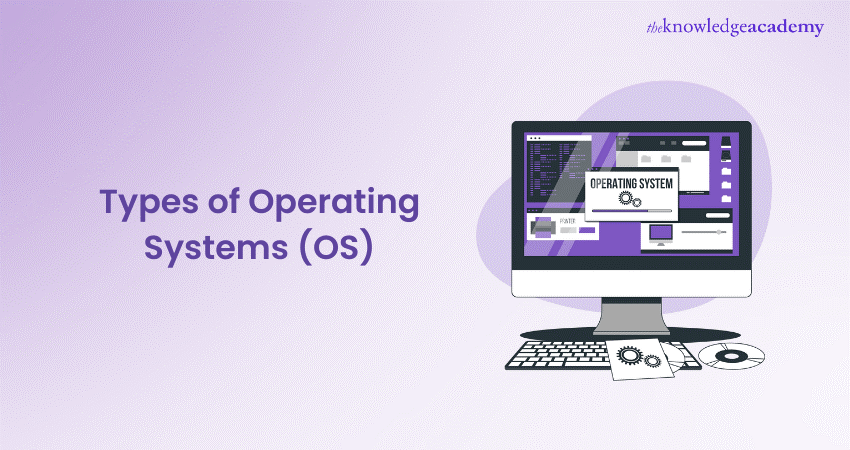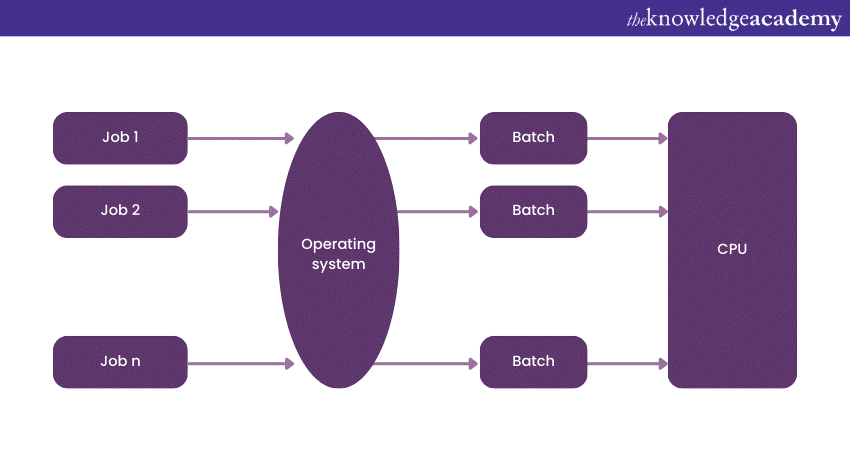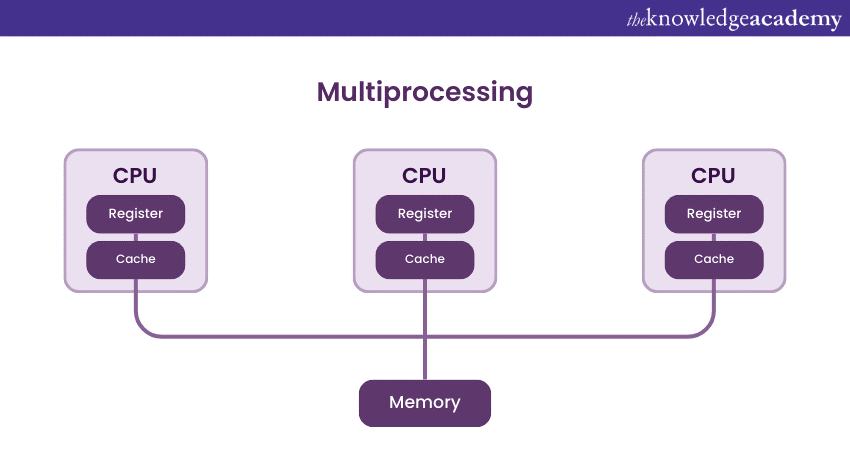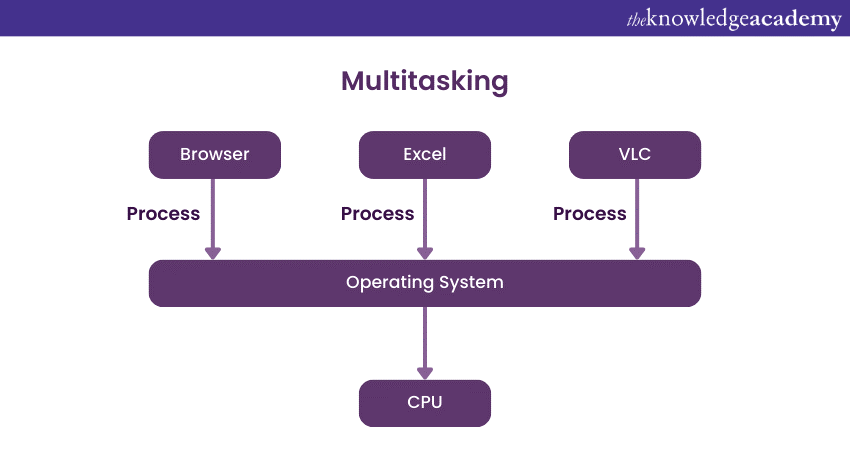We may not have the course you’re looking for. If you enquire or give us a call on +358 942454206 and speak to our training experts, we may still be able to help with your training requirements.
Training Outcomes Within Your Budget!
We ensure quality, budget-alignment, and timely delivery by our expert instructors.

Operating System (OS) is the groundwork for computer systems that allow people to create and run powerful software on their systems. It is the platform for most basic functions within a computer, allowing it to schedule tasks and control peripheral devices connected with it. As time and technology progressed, so did computer science, leading to the creation of various Types of Operating Systems.
According to Statista, the market share of popular Operating Systems like Microsoft Windows grew considerably by 64.27% in 2023. Other popular OS also followed suit, with Android, Linux and MacOS demonstrating a fair share of growth, proving how vital OS is in everyday life. These systems can be categorised based on their working, functionalities and use cases. Some popular Types of Operating Systems include Batch Operating System, Multi-Programming Operating System, and Multi-Processing System.
Table of Contents
1) Different Types of Operating Systems
a) Batch Operating System
b) Multi-Programming System
c) Multi-Processing System
d) Multi-Tasking Operating System
e) Distributed Operating System
f) Network Operating System
g) Real-Time Operating System
2) Conclusion
Different Types of Operating Systems
Operating Systems have evolved for specific roles over time with the progress of technology. As a result, it can be categorised into certain types. Here are some common Operating System types which are frequently used in real life:
Batch Operating System
Batch OS gets its name from the ability to take multiple jobs and categorise them into different batches. It does so with the help of an operator, a different system that sorts these tasks based on their similarities. These tasks are often generated from different systems; hence, it is accessible to more than just one person.

This kind of Operating System, which processes tasks in batches, was at its peak during 1970, commonly used with the mainframe computers. The jobs which need execution will be lined up in a queue, prioritising it in a First Come First Serve (FCFS) order. Batch OS was considered a great option for exceptionally time-consuming and lengthy tasks.
a) Benefits of Batch OS: Batch OS is one of few systems that can accurately predict the time taken for a task, given it is present within its queue. It allows multiple people to work on the same system without causing issues to the overall process. Additionally, it makes managing large chunks of data extremely easy while having a minimum idle time.
b) Limitations of Batch OS: While Batch OS has its fair share of advantages, it also has limitations. One of the common problems people encounter while using this Operating system is known as Starvation. Since this system executes tasks in a batch, theoretically if you have given it five tasks, and the first one takes all the time and resources, all other tasks will get starved. Understanding these limitations is crucial, just as booting in operating systems is for effective system performance.
Multi-Programming System
The Multi Programming Systems are often considered an extension of batch processing. It gets its name from its ability to divide memory and allot each segment to different tasks. Thus, this OS allows multiple programs to run simultaneously, using a system's resources more efficiently. A Multi-Programming OS requires both an IO time and a CPU time, allowing the system to execute a process while another is in the I/O phase.
a) Benefits of Multi-Programming System: As the name of this OS suggests, it increases multi-programming through the system, making it overall more efficient. As a result, resources of the system are rarely idle or going to waste since free memory and computing power are allotted to an undone task. Additionally, this OS reduces the response time of the overall system, making the work significantly faster.
b) Limitations of Multi-Programming System: Multi-Programming Systems are an excellent choice for optimised resource allocation. However, it is a poor choice regarding user interactivity or customisation based on preference. This system has no options for the user to interact with the system’s resources, limiting the overall possibilities.
Interested in learning iAd Integration and App purchases? Our IOS App Development Training is just for you!
Multi-Processing System
Multi-Processing OS was an advancement of the multiprogramming concept, as it utilised multiple CPUs at the same time. The use of multiple processors allowed for parallel processing, allowing it to execute multiple tasks at the same time with greater efficiency. Each processor within this OS can execute its own set of tasks, making it adept at handling a wide array of tasks, such as data analysis.

a) Benefits of Multi-Processing System: Multi-Processing Systems have relatively high throughput, meaning they can deliver a high number of outputs in a limited time. It can also work if one of the processors fails, as it has multiple working for it. This makes it safer to work with, compared to other OS, which do not have a failsafe in case a processor stops working.
b) Limitations of Multi-Processing System: This OS benefits a lot due to the presence of multiple processors. However, this also makes the overall architecture much more complex. As a result of this added complexity, the working of this system and the managing it becomes increasingly difficult.
Multi-Tasking Operating System
Multi-Tasking OS is also known as a Time-Sharing OS due to its ability to allocate a specific time limit to a task. Once the allocated time has run out, the OS makes the system switch and prioritises a different task. This gives it an edge over systems like Batch OS since it can prioritise different tasks simultaneously. This feature was so popular that it became a standard in modern Operating Systems, allowing users to freely switch between applications.

a) Benefits of Multi-Tasking Operating System: Multi-Tasking OS has a list of benefits, including the equal distribution of time and resources for all tasks, lowered software duplication frequency and reduced CPU idle time. This system can share resources among different users, reducing the overall expenses on hardware. Additionally, this system has excellent memory management, leading to a much better user experience.
b) Limitations of Multi-Tasking Operating System: Multi-Tasking OS often suffers from a reliability problem, where you need to manually ensure the security of user data and programs. This problem becomes more prominent in the presence of multiple users on a single system, with an increased chance of security breaches. Additionally, it faces a frequent problem with overheating when dealing with multiple programs.
Wish to learn about UI in detail? Try our Android App Development Training and build powerful applications!
Distributed Operating System
Distributed OS refers to the systems where different computers are connected through a shared network and can communicate freely with each other. This network of interconnected computers is treated as a single cohesive unit rather than a group of different devices. Due to the distributed nature of this system, it is also referred to as the Loosely Coupled System.
Distributed OS has varying sizes of computers and processors connected, allowing for one system to accomplish a task by borrowing resources from another system. It is considered an advancement in computing power and Operating Systems, being frequently used in various scenarios.
a) Benefits of Distributed Operating System: Distributed OS naturally acts as a failsafe during system failure, as one processor being sabotaged does not affect the remaining systems in the network. It has had excellent speed and minimum load on the host computer due to shared resources. This kind of system is also scalable by nature since you can add more computers and processors.
b) Limitations of Distributed Operating System: The Distributed OS is not affected by a system failure; however, it is still vulnerable to network failure. In case the main network of this system fails, the distributed systems will lose their ability to communicate with each other. Additionally, Distributed OS can be extremely expensive due to the number of resources it requires. The expense of this system, combined with the fact that this OS type uses extremely complex language, makes it scarce.
Network Operating System
Network OS refers to the systems that run on a server, commonly used for network device management. These systems are designed to optimise network resources such as data, groups, applications, users, and applications. This system has a coherent configuration well understood by all users working on it; hence, it is also called a Tightly Coupled System.
Networked devices like servers, workstations, and printers are commonly managed using Network OS, as it centralises the overall process. This OS allows the devices to share relevant data with each other using a Local Area Network (LAN). It streamlines the network administration tasks and ensures networked environments' secure and efficient operation.
a) Benefits of Network Operating System: Network OS are extremely stable due to the usage of a centralised server, allowing for easy security handling and integration. This system is easy to upgrade, as the process of adding a new technology to the network is much easier than other systems due to its coupled nature. Its biggest advantage is that it allows the server to be accessed from any location using different systems.
b) Limitations of Network Operating System: Network OS is extremely dependent on constant upgrades and requires high maintenance. Failing at maintenance can result in the system not working properly, thus slowing down the work. This system can be expensive in nature. The purchase for establishing it is quite high, and the regular maintenance also contributes to its expenditure. Additionally, this system depends on the central location for most of its work.
Wish to learn the fundamentals of Code repository and code more efficiently? Try our Git & GitHub Fundamentals Course today!
Real-Time Operating System
Real-Time OS is designed for high-priority applications where each task has a specific deadline, which cannot be altered. These systems are used in environments where timing is critical, such as military, aircraft control, medical devices, robotics, and industrial automation. Over time, these systems have also found use in missile systems due to minimum deviation between the input and response time.
Real-Time OS is mandatory for time-sensitive tasks and is frequently used in scenarios involving life-or-death conditions. This system can be categorised into Soft and Hard Real-Time Systems. Although both have time constraints, Hard Real-Time OS tends to have stricter time constraints, leading to rigid protocols. In comparison, Soft Real-Time OS is more flexible, allowing one task to take priority over another if necessary.
a) Benefits of Real-Time Operating System: Real-Time OS is one of the best OS to exist currently; hence, it can maximise the use of devices and systems. It allows almost instantaneous shifting between tasks while dedicating its focus to the current task. These systems also benefit from excellent memory management and are relatively error-free in nature. Additionally, this system is well suited for embedded systems due to the small size of programs.
b) Limitations of Real-Time Operating System: Real-Time OS is one of the best systems to exist out there when it comes to critical tasks with sharp deadlines. However, this system is poorly suited for general-purpose tasks and everyday use. It has a limited number of tasks it can execute simultaneously to avoid potential errors and can be extremely burdensome on resources. This system works on extremely complex algorithms, which makes it efficient at what it does; however, it also makes working with this system tougher for an average user.
Interested in creating powerful applications? Try our App & Web Development Training!
Conclusion
As we conclude this blog, we hope you were understand the different Types of Operating Systems. Each OS has its respective tasks, and one might be better than the others at certain tasks. They all serve a niche in the world of computing. We hope this blog gives you the confidence to succeed in your future endeavours, whether your studies or roles related to these systems.
Interested in Mobile Games? Got fascinating ideas to make a cool trendy app? Why not try our Mobile App Development Training!
Frequently Asked Questions
Upcoming Programming & DevOps Resources Batches & Dates
Date
 Introduction to HTML
Introduction to HTML
Fri 24th Jan 2025
Fri 28th Mar 2025
Fri 23rd May 2025
Fri 25th Jul 2025
Fri 26th Sep 2025
Fri 28th Nov 2025







 Top Rated Course
Top Rated Course



 If you wish to make any changes to your course, please
If you wish to make any changes to your course, please


